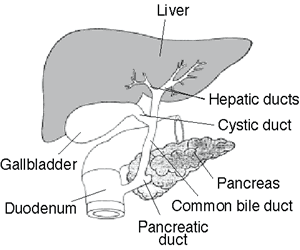Many people have gallstones, especially women, overweight people, and those who are middle aged or over.

Gallstones
Many people have gallstones, especially women, overweight people, and those who are middle aged or over.
What are gallstones?
Gallstones look like small stones or gravel, but are not as hard, and may be up to 3 centimeters across. They are made of cholesterol (a fat) but can include calcium salts (similar to chalk) and solids from red blood cells. They grow in the liver and gallbladder and may take months and years to form. The gall bladder is tucked away under the liver just below the right rib cage and collects bile from the liver. Bile is important in fat digestion and mixes with the food in the intestines. After a meal the gallbladder empties the bile down a tube called the bile duct, into the intestines where it mixes with food for digestion.
What are the symptoms of gallstones?
People with gallstones don’t know they have them until they block the pipes draining the gallbladder, causing inflammation, or move out of the gallbladder and block the pipe leading directly to the intestine, causing jaundice, fever or severe colic. People with gallstones may have indigestion, perhaps noticed after a rich or heavy meal.
The symptoms of gallbladder trouble are pains below the right ribs and sometimes an ache in the back near the shoulder blade. The symptoms that doctors take most seriously are signs of inflammation in the gallbladder causing pain and fever (acute cholecystitis) or turning yellow (jaundice), a sign of obstruction of the liver. Inflammation may feel like flu but often with pain below the ribs. The urine may turn dark and the motions go very pale, and the whites of the eyes may look yellow. Sometimes the skin turns a dusky yellow rather like a suntan.